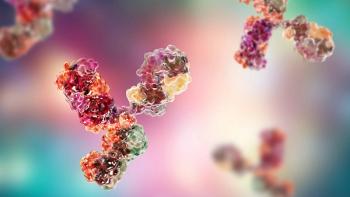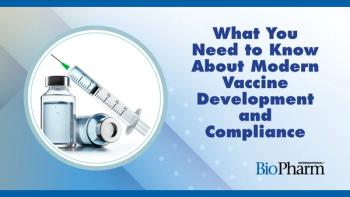
- BioPharm International-02-01-2016
- Volume 28
- Issue 2
Complementary Techniques for the Detection and Elucidation of Protein Aggregation
In this article, the author reviews some of the techniques that can yield valuable information on protein stability, focusing specifically on protein aggregation. Emphasis is placed on the enhanced information made available when technologies are used orthogonally, and the alignment of different approaches with specific stages of the biopharmaceutical development workflow.
Cost-efficient biopharmaceutical development must adhere to the crucial principle “fail early and fail cheap” when eliminating unpromising candidate molecules from the pipeline. To do this in an informed way, it is vital to have sound information to make decisions about which therapeutics offer the most potential. Protein instability, typically caused by aggregation or degradation, is a pre-eminent concern for biologics because of the associated risks of immunogenicity and reduced efficacy. In the earliest stages of candidate validation and formulation development, information that helps detect a tendency toward instability can deliver considerable cost and time savings. As development advances, the requirement shifts to a need to elucidate and control protein stability within an evolving, increasingly complex formulation, and the associated analytical requirements alter accordingly.
Candidate screening: Rapid and robust elimination of low-potential molecules
The progressive refinement of potential therapeutics to develop an optimal biopharmaceutical product often begins with the assessment of a substantial number of candidates. Early screening criteria relate to the assessment of factors including bioefficacy, developability, and manufacturability, and are designed to identify candidates that are not only efficacious but will also lend themselves to simple formulation and profitable manufacture. Propensity to aggregate is one of the screening tests associated with developability, because of the long-term impact of aggregation on product stability.
The most relevant analytical techniques at this early stage combine automation and high throughput with minimal sample volume requirements. At this point, candidates have limited availability, so maximizing the information gained from every microgram of sample is crucial. Lack of sample also results in a need for measurements at low concentration, raising the question of whether results are representative of how the molecule will behave in its final formulation concentration. The requirement for robust and reliable selection means that simple and clear indicators of promising performance are preferable. The measurement of hydrodynamic size (RH), for example, is one of the most effective ways of detecting potential problems with molecular conformation and structure, and stability in solution.
Dynamic light scattering (DLS) and size-exclusion chromatography (SEC) are established techniques for measuring RH and also parameters such as molecular weight, which are extremely helpful in screening candidates for potential protein aggregation. In addition, Taylor dispersion analysis (TDA), a much newer technique, is also now proving valuable and adding beneficial orthogonality at this point in the pipeline.
TDA is a microcapillary flow-based technique that enables rapid and accurate determination of the diffusion coefficients of target molecules, and consequently their RH. Instruments that implement TDA alongside UV detection, such as the Viscosizer TD (Malvern Instruments), measure the size of the target molecule directly in its formulation without interference from other species present, including peptides, formulation excipients, and surfactants. TDA is, therefore, a powerful complementary method to DLS and SEC for identifying outliers on the basis of their size in formulation, possibly due to self-association or conformational changes, which may prove problematic further down the pipeline. For example, Figure 1 shows how TDA can sensitively detect the reduction in hexameric insulin associated with decreasing insulin concentration. In addition, instruments such as the Viscosizer TD provide relative viscosity screening within the same samples, facilitating the removal of candidates with abnormal/unhelpful viscosity profiles--a distinct issue when developing injectable therapeutics--from the pipeline at the earliest opportunity.
Early formulation: Detection, quantification, and characterization of aggregates to improve stability
The successful progression of promising candidates through early-stage formulation relies on a more rigorous assessment of protein aggregation and stability. Because candidate numbers remain high, long-term stability studies for every formulation are infeasible at this point; fast, automated measurements will, therefore, be a priority. Differential scanning calorimetry (DSC) is widely used for the assessment of thermal stability (e.g., for measuring changes in the melting transition midpoint temperature that can be linked directly with stability) and for detecting changes in conformation, via measurement of the associated enthalpy. Highly specified DLS systems, on the other hand, such as the Zetasizer Nano (Malvern Instruments), deliver automated measurement of stability prediction parameters such as:
- B22, the second virial coefficient: an indicator of the strength of electrostatic and hydrophobic bonding
- KD, the DLS interaction parameter: a function of both thermodynamic and hydrodynamic interactions
- Zeta potential: a measure of the overall strength of intermolecular electrostatic interactions.
Higher (either positive or negative) zeta potentials are associated with increased repulsion between molecules and a lower risk of native aggregate formation, which, though often reversible, increases the risk of aggregation of the denatured protein. More positive values of B22 and KD are also associated with stability.
Complementary to the application of DLS at this stage is TDA, because of its ability to detect aggregates in the presence of excipients or other larger particles, and also SEC, especially when implemented with multiple detectors. Unlike DLS and TDA, SEC is not an “in-solution” technique, so it offers an orthogonal approach to building an understanding of aggregation mechanisms as a prelude to exerting effective control.
SEC involves the separation of a sample into fractions on the basis of hydrodynamic size, followed by analysis of each eluting fraction. It is typically deployed, often with a single detector, as a quality control release assay to measure the oligomeric state of a protein. However, with a multiple detector array, SEC becomes a far more powerful tool for investigating the composition and aggregation state of a sample (see Figure 2). The resulting data aid the development of a detailed understanding of the degradation pathways and products associated with aggregation.
A multiple angle light scattering (MALS) detector determines the absolute molecular weight of each species in the sample, thereby characterizing any aggregates present in terms of the number of monomer units involved. Light scattering detection also enables the measurement of hydrodynamic radius and provides an assessment of polydispersity. A UV detector, on the other hand, measures the concentration of chromophore-containing species to reveal the percentage of aggregation. Adding a viscometer to the detector array brings intrinsic viscosity data, which, in combination with molecular weight measurements, can be used to quantify the structural characteristics of any protein species present to further elucidate aggregation mechanisms.
Late formulation: Understanding structural stability to achieve effective control
By late-stage formulation, although the number of drug candidates would have dropped, drug developers are required to provide more information on the formulation. Here, there is a need for analysis that provides deeper insight into aggregation mechanisms and the factors that influence them, including the impact of possible excipients. This requirement is essential for the adoption of the rigorous quality-by-design approach, integral to biopharmaceutical development.
Previously mentioned techniques continue to have applications here. For example, the ability of TDA to measure the size of the target molecule in an increasingly complex formulation is extremely helpful in ensuring the structure-function relationship of the target protein is not altered. The detailed information and structural insights offered by SEC are also valuable. But alongside these various approaches, other complementary techniques are added to the mix for more detailed investigation.
One such technology is the resonant mass measurement (RMM), which, with a measurement range of 50 nm to 5 µm and the ability to differentiate particles on the basis of their buoyancy in suspension, is deployed to distinguish proteinaceous particles including aggregates from other species present, such as silicone oil, glass, or air bubbles. Other novel techniques of proven value at this point include extensions to DLS; for example, DLS combined with Raman spectroscopy in instruments such as the Zetasizer Helix (Malvern Instruments), which boosts DLS with its chemical identification capabilities.
A primary strength of DLS is its high sensitivity monitoring of protein size and its ability to detect low levels of aggregated material. Light scattering intensity scales with molecular diameter to the power of six, so the hydrodynamic size data reported by DLS is strongly influenced by the size of the largest aggregates present. This means that DLS systems can rapidly detect the onset of aggregation. Adding Raman spectroscopy enables the detailed investigation of detected aggregates to uncover unique insights into protein folding, unfolding, aggregation, agglomeration, and oligomerization. Figure 3, for example, shows how Raman spectroscopy can be used to investigate structural changes associated with protein instability.
In combination, DLS and Raman spectroscopy also enable an orthogonal approach to DSC for the determination of melting temperature (TM) and van’t Hoff enthalpies, which are crucial parameters relating to thermodynamic behavior and thermal stability. All experiments can be carried out with minimal dilution to study the protein in its native state within the formulation.
Conclusion
Informational requirements along with practical constraints, such as sample availability, mean that certain analytical techniques are optimally suited to specific stages of the drug-development pipeline. Verifying that the beneficial structure-function relationship of a biologic is maintained as formulations become more complex is essential, but it presents an increasing analytical challenge because of the associated need to differentiate the molecule of interest, gather data for it, and understand the impact of added excipients. As instrumentation suppliers continue to innovate, new techniques are being commercialized to answer to these evolving needs and deliver the information needed to progress. Understanding what can be measured, and how, is key to applying complementary methods in a cost-effective way to advance biopharmaceutical development.
Article Details
BioPharm International
Vol. 29, No. 2
Pages: 46-49
Citation: When referring to this article, please cite it as L. Newey-Keane, " Complementary Techniques for the Detection and Elucidation of Protein
Articles in this issue
almost 10 years ago
Antibody Production in Microbial Hostsalmost 10 years ago
Advances in Assay Technologies for CAR T-Cell Therapiesalmost 10 years ago
Innovative Therapies Require Modern Manufacturing Systemsalmost 10 years ago
Macro Mattersalmost 10 years ago
Fine Tuning the Focus on Biopharma Analytical Studiesalmost 10 years ago
Biopharma Innovation Born Again?almost 10 years ago
Failure Mode Effects Analysis for Filter Integrity Testingalmost 10 years ago
The Emerging View of Endotoxin as an IIRMIalmost 10 years ago
Use of an E. coli pgi Knockout Strain as a Plasmid Produceralmost 10 years ago
BioPharm International, February 2016 Issue (PDF)Newsletter
Stay at the forefront of biopharmaceutical innovation—subscribe to BioPharm International for expert insights on drug development, manufacturing, compliance, and more.





